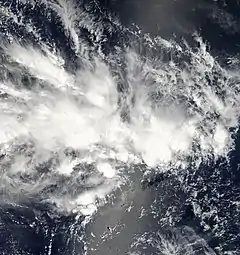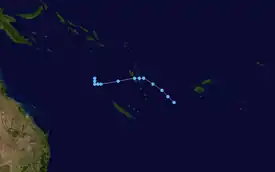January 2009 Fiji floods
During January 2009, Fiji was impacted by a series of consecutive weather events, that caused severe flooding in various parts of the island nation. The floods were caused by a number of intense synoptic-scale weather features, which included an active monsoonal trough, the South Pacific Convergence Zone, Tropical Depression's 04F and 05F as well as Tropical Cyclone Hettie. These weather features combined to cause strong winds, considerable rainfall, as well as severe flooding across the island nation throughout the month.
 Tropical Depression 04F on January 4, 2009 | |
| Date | January 2009 |
|---|---|
| Location | Fiji |
| Cause |
|
| Deaths | 11 |
| Property damage | 64.2 |
Meteorological synopsis

Tropical storm (39–73 mph, 63–118 km/h)
Category 1 (74–95 mph, 119–153 km/h)
Category 2 (96–110 mph, 154–177 km/h)
Category 3 (111–129 mph, 178–208 km/h)
Category 4 (130–156 mph, 209–251 km/h)
Category 5 (≥157 mph, ≥252 km/h)
Unknown
During January 2009, Fiji was impacted by a series of consecutive weather events, that caused severe flooding in various parts of the island nation.[1] These events included: an active monsoonal trough, an enhanced South Pacific Convergence Zone, Tropical Depression's 04F and 05F as well as Tropical Cyclone Hettie.[2] These weather features combined caused strong winds, considerable rainfall, as well as, severe flooding across the island nation throughout the month.[2]
During January 6, the SPCZ combined with a vigorous monsoon trough moved over Fiji, where it produced intense and persistent rain as well as strong winds over the islands.[2] Tropical Depression 04F subsequently brushed past the island nation between January 6 - 9, after it had been first noted to the west of Vanuatu during January 5.[2] As the monsoon trough moved northwards during January 11, there was a brief respite from the weather over the most of the islands, however, the weather deteriorated as the trough drifted southwards during January 13.[2] The SPCZ and the trough subsequently drifted northwards and hovered over northern Fiji during January 15, as a ridge of high pressure moved in from the south.[2]
Several tropical disturbances subsequently developed and moved eastwards along the monsoon trough, however, none of these was as significant as Tropical Cyclone Hettie's precursor tropical disturbance.[2] Hettie extended a trough of low pressure over the islands, which caused heavy rain and strong southerly winds over Fiji's Southern, Central and Eastern Divisions.[2] As a result of this, severe flooding was reported over the interior and eastern parts of Viti Levu, during January 28 and 29, with rainfall totals of over 100 mm (3.937 in) recorded at Vatukoula, Nacocolevu, Koronivia, Nausori Airport and Tokotoko-Navua.[2]
Preparations and impact
The 2009 Fiji floods occurred on January 10, 2009, and the following days after Tropical Depression 04F hit the western section of the island of Viti Levu in Fiji.[3] This area is ordinarily the "dry" side of the island. The floods left eleven people dead, including three teenagers,[4][5] with six drowning in the flood waters, and a landslide killing another two.[3] In some areas, flood waters reached heights of up to 3 meters.[6]
Tropical Depression 04F brought heavy rainfall to the Northern, Central and Western divisions of Fiji from January 8 until January 10.[7] There was a total of eleven people killed within Fiji whilst over 6,000 people were displaced and went to 114 emergency shelters,[8] and were given "meals...biscuits, milk and other dry stock."[9] In addition, power and telephone lines have been downed,[4] and many roads were rendered impassable.[10] Sugarcane, an important crop in the affected region, was heavily destroyed.[6] Frank Bainimarama, the interim Prime Minister, declared a state of emergency, and said that the government is working diligently to assist in relief efforts.[9] Because of the state of emergency, there are mandatory curfews in several large towns to prevent looting.[9] The damage was estimated at 112.99 million FJD (US$64.2 million).[11]
At least 600 tourists, mostly from New Zealand, were left stranded by the flooding.[12]
Aftermath and response
Australia donated approximately AU$3 million (US$2.12 million) to the Relief fund. This was made up of AU$1 million (US$707,000) for immediate assistance and AU$2 million (US$1.41 million) for long-term assistance.[13] AusAID also donated just under 390,000 FJD (US$222,000) to assist with the repairs to school infrastructure and the provision of resources to flood-affected schools.[14] New Zealand also donated near NZ$4 million (US$2.35 million) to the relief fund.[15] This was made up of NZ$3 million (US$1.76 million) for long term recovery and NZ$80,000 (US$47,000) for the educational needs of people in the areas that were hardest hit by the depression.[15] The European Union also donated over $2 million FJD (US$1.14 million), which was also for rehabilitation of schools as well as paying of some of the fees that students are required to pay.[16] The Governments of the United Kingdom, China, France, Tonga, Korea and Samoa each contributed money to the relief fund totaling up to 286,000 FJD (US$162,000).[17] Whilst the governments of Papua New Guinea, New Caledonia, and India pledged over US$700,000 to the relief effort and for reconstruction efforts.[17] The US Embassy and the China Red Cross also donated just under 120,000FJD worth of goods for relief efforts.[17]
References
- Lal, Padma Narsey; Rita, Rashmi; Khatri, Neehal (October 5, 2009). Economic Costs of the 2009 Floods in the Fiji Sugar Belt and Policy Implications (PDF) (Report). International Union for Conservation of Nature and Natural Resources. ISBN 978-2-8317-1175-1. Archived (PDF) from the original on 2020-11-22. Retrieved November 22, 2020.
- Fiji Islands Climate Summary: January 2009 Volume 30: Issue: 1 (Report). Fiji Meteorological Service. February 2009. Archived from the original (PDF) on February 29, 2012. Retrieved November 7, 2020.
- "Floods in Fiji kill 8; thousands seek shelter". AP. 2009-01-12. Retrieved 2009-01-12.
- "New Zealand to give 100,000 NZ dollars for Fiji flood relief". Xinhua. 2009-01-12. Archived from the original on January 20, 2009. Retrieved 2009-01-12.
- "Fiji flooding death toll climbs". BBC. 2009-01-14. Retrieved 2009-01-16.
- "Flooded Fiji declares emergency". Al Jazeera. 2009-01-12. Retrieved 2009-01-12.
- United Nations Office for Coordination and Humanitarian Affairs (2009-01-13). "Fiji: Floods Situation Report No. 1" (PDF). Reliefweb. Archived from the original (PDF) on 2011-03-20. Retrieved 2009-02-07.
- "Six feared dead in Fiji flooding". BBC. 2009-01-12. Retrieved 2009-01-12.
- Veisamasama, Malakai (2009-01-12). "Storm-hit Fiji declares state of emergency". Washington Post. Retrieved 2009-01-12.
- Dart, Jonathan (2009-01-13). "Fiji floods kill eight, strand thousands". Sydney Morning Herald. Retrieved 2009-01-12.
- Consolidated report on flash floods (PDF) (Report). Office of the Prime Minister. 2009-02-19. Retrieved 2009-02-18.
- Burgess, Dave (2009-01-12). "Fiji floods strand Kiwis". The Dominion Post. Archived from the original on 2009-01-20. Retrieved 2009-01-12.
- Stephen Smith (2009-01-16). "Further Australian assistance for Fiji floods". Reliefweb. Retrieved 2009-02-06.
- Filipe Bole (2009-02-05). "AusAID assistance for flood-affected schools". Reliefweb. Retrieved 2009-02-06.
- Murray McCully (2009-02-02). "Further $3 million for Fiji flood relief". Reliefweb. Retrieved 2009-02-06.
- Filipe Bole (2009-01-27). "$2m assistance from EU for flood affected schools". Reliefweb. Retrieved 2009-02-06.
- United Nations Office for Coordination and Humanitarian Affairs (2009-01-30). "Fiji: Floods Situation Report No. 5". Reliefweb. Retrieved 2009-02-06.